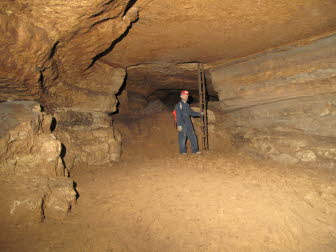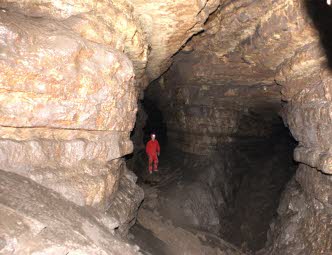

|
HOLY GRAIL CAVE |
| Holy Grail Cave, located in S.E. Minnesota, was discovered in 2008 after a rare catastrophic supercell rain storm collapsed the roof of a tall dome. Explorers rappelled 50’ down into the cave and went on to discover possibly the largest rooms, passages, pits and domes in the Tri-State region. It is thought that this cave is part of the huge York/Odessa underground drainage system that explorers have been attempting to enter since the 1800’s. To date 4 miles of passages have been explored, and cavers are searching for the connecting passage that may lead them into the York/Odessa drainage system. It is estimated that this system may contain over 50 miles of cave passages. The Minnesota Cave Preserve owns 11 surface acres above the caves only entrance, and 148 acres of subsurface rights to this complicated cave system. Download the STORY View the MAP Read the HISTORY |
On June 7th, 2008 a catastrophic supercell rain event, which spawned brief hail, tornadoes and damaging winds, hit Fillmore County. Eleven inches of rain pounded down in a short period of time, which caused significant flooding. Major roads were closed, and the nearby town of Granger, located along the Upper Iowa River, was surrounded by water. |
|
| From
devastation came exuberance! Sometime later John Ackerman received a phone
call from Dan Dornink, a fellow caver, lifelong resident of the area and
Fillmore County Sheriff’s Deputy. He described a gaping hole that had
opened up during the storm event in a farm field, along the York/Odessa
corridor. Dan suggested that John bring the full caving arsenal. |
|
We
know that a major cave system exists, beginning from the largest blind
valley in Minnesota (The York Blind Valley) and ending 10 miles away,
at the largest spring (Odessa Spring) in Minnesota. Dye traces conducted
by Dr. Calvin Alexander have shown that water from 12 square miles drains
into the York Blind Valley. Dye tracing has also proven that this water
meanders through the earth until finally discharging from Odessa Spring,
located at the base of a magnificent limestone cliff along the Upper Iowa
River. (Along the Minnesota/Iowa border.) This 2001 photo shows Matthew
Ackerman at Odessa Spring. |
|
| John
Ackerman and Clay Kraus peer into the newly collapsed hole. This site
is about 4 miles from the York Blind Valley, right along the suspected
underground corridor which stretches into Iowa. Since the 1800’s explorers
have attempted to find this fabled underground cave system. Could this
be it? |
|
The open abyss was found to be 50’ deep. While Clay, Dan and Dave Gerboth were engrossed with a lead near the entrance shaft, John Ackerman explored in the opposite direction. John located a tiny crack along the edge of a narrow low passage with wind blowing out from beyond. |
|
| John removed loose soil, sand and rocks, and worked his way upward, following a tiny void. Soon he saw open blackness and climbed up into a large room. He walked around the room but could not locate the continuation, so again he searched for the wind source. Again John noted a crack along the floor and dug up into a spacious passage. He followed the passage for several hundred feet and encountered a stunningly huge intersection - open blackness could be seen in both directions. He retraced the route back, regrouped with Clay, Dan and Dave, and together they explored beyond John’s turn around point. |
|
We
turned the corner and found this! Could we have discovered the York/Odessa
Cave System? |
|
| It
was immediately apparent that this newly discovered cave be protected.
This open sinkhole needed to be capped. Not only was it a serious liability
issue, it was also a hungry monster, just waiting to swallow tons of fertile
black soil from the surrounding fields during heavy rain events. Even
though the sinkhole was on private property the Minnesota Cave Preserve
felt the need to step forward and spearhead this project. This photo shows
the placement of structural tube beams over the hole. |
|
Thick plywood was placed over the beams and rebar was installed. Sheets
of tin were placed along the perimeter to form a tight seal. A temporary
access to the cave was installed. |
|
| High
strength concrete was poured over the works. |
|
The
site was backfilled and a culvert extension was added. The 4 owners of
the property (Ed, Glenn, John & Kay Ivers) were supportive of John’s
quest to preserve, study and protect this unique underground wilderness.
They subsequently sold John 11 surface acres and 148 acres of subsurface
cave rights. |
|
| A
new entrance will be installed in a more appropriate location (approx.
400’ northeast of the original entrance) on John’s newly purchased land,
and this temporary entrance will be removed. |
|
A
specialized rig bored a small diameter hole down into the cave to verify
the accuracy of the new 30” diameter shaft. The original sinkhole site
remains the property of the Ivers. |
|
|
The new entrance was created by this drill rig. |
|
The actual breakthrough
was filmed from inside the cave-a never before filmed event. |
|
|
Javier Guzman stands at the new entrance into Holy Grail Cave, which is
65 feet below the surface. |
 Click for larger view |
As
the cave is explored it is surveyed. A map is then created and the surface
features are superimposed on the final draft. |
|
|
We have discovered possibly the largest rooms, passages, pits and domes
in Minnesota. |
 Click for larger view |
To
date over 4 miles of cave passages have been discovered. |
|
| Ninety
seven percent of the cave lies under the land that is protected by John’s
(Minnesota Cave Preserve) subsurface rights. |
|
Explorers continue to search for the passage that may connect to the vast York/Odessa Cave System. If discovered, it is estimated that the entire cave system could contain more than 50 miles of cave passages! In June, 2009 fluorescein dye was poured amongst droplets that continually fall to the cave floor in this room. Within several weeks the dye was picked up and identified by special receptors at the Odessa Spring resurgence. Positive proof has now been established that this cave lies directly over the York/Odessa drainage system.
|
|
| Numerous
deep pits have been discovered, and some contain water of unknown depths.
Several such pits were rigged with ropes, and one explorer (John Ackerman)
descended down into the depths in a wet suit to investigate. It is hoped
that cave divers can probe these water filled pits and find a conduit
which could lead directly into the extensive York/Odessa System. |
|
After working for several years, a bypass has been created to link the difficult to enter Golden Section to close proximity to the main cave entrance. This required blasting a 47' long tunnel, combined with a 56' dirt tunnel.
Photo of John Ackerman.
|
|
| Divers
have now discovered a subterranean labyrinth of stream passages and are
advancing towards what geologists predict will be the main river passage.
This totally water filled borehole will lead directly to Odessa Spring,
located along the Upper Iowa River. |
| Holy
Grail Cave History Home |